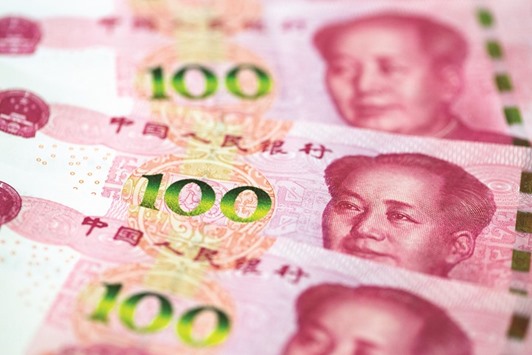China is getting the best of both worlds with its exchange-rate policy.
Its central bankers guided the yuan to a second straight monthly gain versus the dollar in March, while allowing it to drop to a 16-month low against a trade-weighted currency basket.
The yuan’s strength versus the greenback will help curb capital outflows and boost China’s foreign-exchange reserves, which fell last year for the first time, according to Credit Suisse Group.
And its decline against the basket will help exports, says ABN Amro Bank, the top forecaster of the yuan in Bloomberg’s most recent survey.
“There’s more scope for the yuan to depreciate on a trade-weighted basis, and there’s probably no hard limit on the downside,” said Jason Daw, head of Asian foreign-exchange strategy at Societe Generale in Singapore. “Part of the reason for the yuan’s strength against the dollar recently is the central bank’s efforts to reduce speculative pressure on the Chinese currency.”
China’s exchange-rate strategy has implications far beyond its own borders.
Staying competitive with its trading partners reduces the risk the nation will have to repeat the devaluation that shook global markets in August and helped wipe more than $8tn off global stocks in the first six weeks of 2016.
The potential domestic benefits are also leading to speculation that the world’s second-largest economy is the biggest winner of a detente in the competitive devaluations known as currency wars. The People’s Bank of China is being helped by signs that monetary authorities in Europe and Japan won’t expand their currency-depreciating stimulus programs much further. It’s also benefiting from a less hawkish Federal Reserve, which is capping the greenback’s gains.
“Independent central banks are coming roughly to the same conclusion that, if world economic conditions worsen, it’s worse for them,” said Adnan Akant, head of currencies in New York at Fischer Francis Trees & Watts, which has about $38bn under management. “It took some time for them to appreciate that. It’s OK if the euro is stronger if China is in a better shape.”
The onshore yuan climbed to 6.4490 per dollar on Thursday, its strongest level this year, while the offshore currency jumped 1.62% since December in its best quarterly performance since 2011. The rate in Shanghai was trading at 6.4628 yesterday.
A Bloomberg replica of the CFETS RMB Index, which the PBOC uses to track the yuan against 13 exchange rates, fell below 98 for the first time since 2014 this week. The euro and yen, which have both strengthened more than 4% versus the dollar this quarter, have a combined 36% weighting in the basket.
The Chinese currency saw a small-scale decline in March and remained basically stable against the basket, according to an unsigned commentary posted Friday on the China Foreign Exchange Trade System’s website.
ABN Amro sees the index dropping 4% by year-end to 93.8. Credit Suisse says that a decline in the index to below 97 could discredit the government in the eyes of investors.
That would be an issue for China, which is keen to promote the yuan as a stable currency of global trade after the International Monetary Fund added it to its list of major reserve currencies last year.
PBoC Governor Zhou Xiaochuan said in Paris on Thursday that China will make greater use of its so-called Special Drawing Rights status. And in February, he pledged to keep the yuan stable against its peers while increasing two-way volatility versus the dollar.
Any economic benefits from its exchange-rate policy could scarcely come at a better time for China.
Standard & Poor’s cut the outlook on the nation’s credit rating to negative on Thursday, saying its economic re-balancing is likely to be slower than previously expected.
China’s exports dropped for an eighth straight month in February, supporting the need for a weaker exchange rate to keep down prices of its shipments.
China burned through $513bn of reserves last year as it propped up its currency to punish speculators betting on depreciation.

China’s central bankers guided the yuan to a second straight monthly gain versus the dollar in March, while allowing it to drop to a 16-month low against a trade-weighted currency basket.
